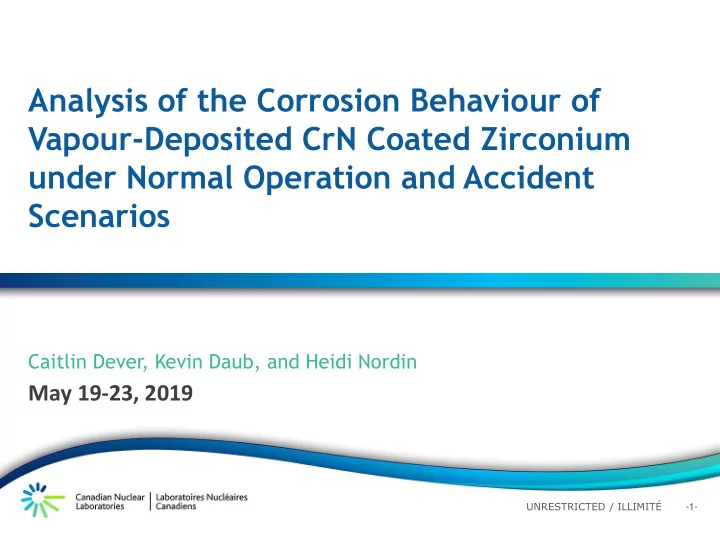

Analysis of the Corrosion Behaviour of Vapour-Deposited CrN Coated Zirconium under Normal Operation and Accident Scenarios Caitlin Dever, Kevin Daub, and Heidi Nordin May 19-23, 2019 UNRESTRICTED / ILLIMITÉ -1-
Introduction Zircaloy-based fuel claddings prone to excessive hydrogen • evolution during LOCA Use of nitride-based coatings may be used for: • Increased hardness, protection against wear, corrosion • resistance, and to reduce hydrogen ingress Commercially available CrN coatings were applied by PVD on • Zircaloy-2 and Zr-2.5Nb substrates Investigations focused on corrosion resistance, accident • tolerance, and the effects of irradiation Zr(s) + 2H 2 O(g) → ZrO 2 (s) + 2H 2 (g) UNRESTRICTED / ILLIMITÉ -2-
Physical Vapour Deposition Sputtering Target Ar + Sputtered Target Atom Sputtering Gas Substrate Thin Film 1 µm Vacuum deposition process using plasma sputtering • bombardment Relatively thin films may be deposited (2-4 μ m) • Deposited coatings may be harder and more corrosion • resistant than coatings deposited through cathodic arc deposition or electroplating UNRESTRICTED / ILLIMITÉ -3-
Experimental Coatings and materials studied Uncoated Zircaloy-2 • Uncoated • CrN-coated • CrN-coated CrN-coated and scratched • Scratches made with milling • tool, approximately 40 µm deep CrN-coated and scratched Zr-2.5Nb • Uncoated • CrN-coated • UNRESTRICTED / ILLIMITÉ -4-
As-Prepared CrN-coated Zircaloy-2 Chromium Nitrogen Zirconium 1 μ m 1 μ m 1 μ m 1 μ m UNRESTRICTED / ILLIMITÉ -5-
Experimental Aqueous Corrosion Testing Solution included D 2 O adjusted to pH a25 ° C 10.5 using LiOH • System purged with Ar for 4 hours prior to test start • Specimens tested at 300 ° C, exposed in autoclave in 30 day • increments up to a total exposure of 120 days UNRESTRICTED / ILLIMITÉ -6-
CrN-coated Zircaloy-2 Aqueous Corrosion Testing μ μ B C A A 120 days Oxide scratched μ μ 10 μ m μ B 2 μ m μ A B 120 days non-scratched B A μ 10 μ m 2 μ m μ μ μ UNRESTRICTED / ILLIMITÉ -7- μ μ
CrN-coated Zircaloy-2 Aqueous Corrosion Testing – 120 days Chromium Oxygen Nitrogen Zirconium 200 nm 200 nm 200 nm 200 nm 200 nm UNRESTRICTED / ILLIMITÉ -8-
CrN-coated Zircaloy-2 Aqueous Corrosion Testing UNRESTRICTED / ILLIMITÉ -9-
CrN-coated Zircaloy-2 Aqueous Corrosion Testing UNRESTRICTED / ILLIMITÉ -10-
Experimental Steam Oxidation Testing Specimens exposed in an Ar-purged quartz tube with a water • flow rate of 1.5 mL/min 24 h at 1000 °C 24 h at 400 °C 24 h at 400 °C cool 6 h at 1000 °C UNRESTRICTED / ILLIMITÉ -11-
CrN-coated Zircaloy-2 Steam Oxidation Testing Zircaloy-4 Zircaloy-2 ZrO 2 2 mm 1.8 mm ZrO 2 Zircaloy-4 Zircaloy-2 200 µm 200 µm CrN CrN 1.4 mm CrN CrN Zircaloy-2 ZrO 2 ZrO 2 100 µm 2 µm UNRESTRICTED / ILLIMITÉ -12-
Experimental In-reactor Testing Exposed in reactor to pH a25 ° C 10.7 adjusted using LiOD • 280 °C 0 n/cm 2 /s 325 °C 280 °C 1.37×10 13 n/cm 2 /s 325 °C UNRESTRICTED / ILLIMITÉ -13-
Zircaloy-2 Exposed In-Flux Uncoated CrN-coated 280 ° C Cr-oxides Zr-oxide 2 µm 2 µm Zr-oxide 325 ° C Cr-oxides 2 µm 2 µm UNRESTRICTED / ILLIMITÉ -14-
Zr-2.5Nb Exposed In-Flux Uncoated CrN-coated 280 ° C Zr-oxide Cr-oxides 2 µm 2 µm 325 ° C Cr-oxides Zr-oxide 2 µm 2 µm UNRESTRICTED / ILLIMITÉ -15-
Weight Gains of CrN-coated Zircaloy-2 and Zr-2.5Nb Tested In-reactor 30 40 Zircaloy-2 25 Zircaloy-2 coated 35 Zr-2.5Nb Average Mass Gain (mg/dm 2 ) Average Mass Gain (mg/dm 2 ) Zircaloy-2 coated+scratched 20 Zr-2.5Nb coated 30 15 25 10 20 5 15 0 10 -5 5 -10 0 -15 280°C - no flux 280°C - in flux 325°C - no flux 325°C - in flux 280°C- no flux 280°C - in flux 325°C - no flux 325°C - in flux UNRESTRICTED / ILLIMITÉ -16-
Deuterium Ingress of CrN-coated Zircaloy-2 and Zr-2.5Nb Tested In-reactor UNRESTRICTED / ILLIMITÉ -17-
Conclusions PVD CrN-based coatings have been found to survive on • Zircaloy-2 under aqueous corrosion conditions and reduce overall deuterium ingress PVD CrN-based coatings may lower steam oxidation • When scratched, coating adherence is not compromised and • further oxidation is limited When exposed out-of-flux and in-flux at 280 ° C and 325 ° C, • PVD CrN-based coatings resist severe surface oxidation UNRESTRICTED / ILLIMITÉ -18-
Acknowledgements Reka Szőke (IFE-Halden) for in-reactor exposure testing • Linruo Zhao (NRC) for coating deposition through PVD • Connor Davis (CNL) for autoclave testing • Sridhar Ramamur (Western University) for steam exposure • testing Clinton Mayhew (CNL) for SEM analysis • Brad Payne (CNL) for SIMS analysis • Alan Britton and Ryan Macleod (CNL) for HVEMS analysis • Travis Casagrande (McMaster University) for FIB lift-outs • Andreas Korinek (McMaster University) for TEM/EELS analysis • UNRESTRICTED / ILLIMITÉ -19-
Thank you. Merci. Questions? Presenting author’s email contact: heidi.nordin@cnl.ca UNRESTRICTED / ILLIMITÉ -20-
Experimental Uniaxial Tensile Testing • Uniaxial tensile tests conducted at RT and 300 ° C • Specimens tested to set strains: • 0.5% • 1% • 1.5% • 2% • Al block used to heat specimens to 300 °C • UNRESTRICTED / ILLIMITÉ -21-
Uniaxial Tensile Tests CrN-coated Zircaloy-4 tested at 300 ° C to 2% strain • UNRESTRICTED / ILLIMITÉ -22-
Uniaxial Tensile Tests Test Temperature Strain (%) Presence of small (°C) cracks 25 0.5 No 25 1 No 25 1.5 No 300 1 No 300 1.5 No 300 2 Yes 300 2.5 Yes UNRESTRICTED / ILLIMITÉ -23-
Recommend
More recommend